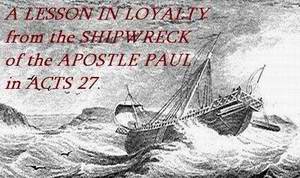|
TITANIC;
LESSONS
By Fred London |
 The Titanic goes down with terrible loss of life.
The Titanic goes down with terrible loss of life. There were too few lifeboats; And those not filled. |
|
TITANIC;
LESSONS
By Fred London |
 The Titanic goes down with terrible loss of life.
The Titanic goes down with terrible loss of life. There were too few lifeboats; And those not filled. |
WILL THERE BE ENOUGH LIFE-BOATS? There is much benefit derived through the study of history; lessons to be learned through the recorded experiences of others who have gone before us. “For whatever was written in earlier times was written for our instruction...” It is on that line that the Institutional Church, particularly that in America, is on an eerily similar course to that of the doomed luxury ocean liner, Titanic.
Hauntingly, the Institutional Church shares many of the same characteristics and influencing factors which ultimately led to Titanic’s sudden and tragic demise, along with great loss of life. Issues dealing with life and death take precedent over virtually all else, and it is this principle that should compel us to take a closer examination of the suggested parallels “to see whether these things be so.” It must be noted that the emphasis is on the application of spiritual parallels and principles, and not in precise and specific prophetic fulfillment.
And for those who are convinced as to “whether these things be so,” it will inevitably beg the question, “What then shall we do?” The correct answer to that eternal question is merely the beginning of an extended process. Many will not proceed beyond that initial recognition. The implications alone will be daunting enough. The applications of those who are willing to live out their convictions will do so at great personal cost, requiring no less than the Spirit of God to see them through.
“Where there is no vision, the people perish.” May we learn much from Titanic. May we receive and respond to, what may well be, a God-given “vision” relevant to our time, whereby many will be spared from perishing in that day. “For it is not His will that any should perish...”
For her time, Titanic was unsurpassed in luxury and opulence and was technologically advanced for the period. ‘Because you say, “I am rich, and have become wealthy, and have need of nothing...” Ironically, this great ship took 3 years to build and less than 3 hours to sink upon hitting the iceberg. On Sunday, April 14th, at 11:40PM, she struck the iceberg, sinking two hours and forty minutes later at 2:20AM on Monday. "Woe, woe, the great city, in which all who had ships at sea became rich by her wealth, for in one hour she has been laid waste.”
Furthermore, the first-class passenger list for Titanic’s maiden voyage included some of the richest and most prominent people in the world. Today, there are many “leaders” situated in the equivalent of a first-class section of the American Church who enjoy a wealth and prominence far beyond the typical Christian. The disparity is especially telling when compared with those outside this country.
Prior to the tragedy, emphasis was placed on the cosmetic aspects of the ship. After the tragedy, safety took priority. The focus changed to the engineering design and structural integrity of the ship. As a result, the hull was reinforced and bulkheads were extended into higher walls to make compartments fully watertight. It is no coincidence that the critical importance of walls is quite evident when reading books such as Ezra and Nehemiah.
“And the rain descended, and the floods came, and the winds blew, and burst against that house; and yet it did not fall, for it had been founded upon the rock.” “According to the grace of God which was given to me, as a wise master builder I laid a foundation, and another is building upon it. But let each man be careful how he builds upon it. For no man can lay a foundation other than the one which is laid, which is Christ Jesus.”
Another design flaw was that the Titanic’s rudder, though not legally too small for a ship of its size, was in fact far too small and thin to accommodate a such a large vessel. Apparently, no account was made for advances in scale, and little thought was given to how a ship of that immense size could possibly turn in an emergency, such as it was required to do on the fateful night. It was a veritable juggernaut which had limited ability to change direction. The size and momentum were just too great to avoid disaster. “Nor do men put new wine into old wineskins; otherwise the wineskins burst, and the wine pours out, and the wineskins are ruined; but put new wine into fresh wineskins, and both are preserved.”
Perhaps even more fatal to Titanic was her triple-screw engine configuration, which had reciprocating steam engines driving its wing propellers, and a steam turbine driving its center propeller. The reciprocating engines were reversible, while the turbine was not. Since the center turbine could not reverse engines to avoid the iceberg, the lst Officer inadvertently handicapped the turning ability of the ship. Since the center turbine could not reverse during the “full speed astern” maneuver, it simply stopped turning. Furthermore, the center propeller was positioned forward of the ships’s rudder, diminishing the turning effectiveness of the rudder.
Had the lst Officer reversed the port engine, and reduced speed while maintaining the forward motion of the other two propellers (as recommended in the training procedures for this type of ship,) experts theorize that Titanic might have been able to navigate around the iceberg without a collision. However, given the closing distance between the ship and iceberg at the time the bridge was notified, this might not have been possible.
The bottom line was that the steering mechanism was far too complex to be used effectively in an emergency situation of this type. “But I am afraid, lest as the serpent deceived Eve by his craftiness, your minds should be led astray from the simplicity and purity of devotion to Christ.”
Subsequently, the conclusion of the British Inquiry into the sinking was “that the loss of the said ship was due to collision with an iceberg, brought about by the excessive speed at which the ship was being navigated.” Throwing caution to the wind, it is alleged that the manager of the ship company compelled the captain to increase the cruising speed in order to impress and set a new Trans-Atlantic record despite the threat of icebergs in those waters. “A man with an evil eye hastens after wealth, and does not know that want will come upon him.”
The American Church is now replete with what the apostle Paul referred to as “another gospel,” teachers and teachings emphasizing wealth, power, and fame. It is immediate, fleshly gratification packaged and sold as a spiritual, God-given right. “For all these things the Gentiles eagerly seek.”
Jesus spoke these words to the Jews, and this was anything but a compliment. And yet, having already provided a list of causes for this terrible tragedy, no single aspect regarding the huge loss of life from the Titanic disaster has provoked more outrage than the fact that the ship did not carry enough lifeboats for all her passengers and crew. This was partially due to the fact that the law, dating from 1894, required a minimum of 16 lifeboats for ships over 10,000 tons. Since then the size of ships had increased rapidly, meaning that Titanic was legally required to carry only enough lifeboats for less than half of her capacity. Actually, the ship’s company exceeded the regulations by including four more collapsible lifeboats - making room for slightly more than half capacity. “All things are lawful, but not all things are profitable.”
In the busy North Atlantic sea lanes it was expected that in the event of a serious accident to a ship, help from other vessels would be quickly obtained, and that the lifeboats would be used to ferry passengers and crew from the stricken vessel to her rescuers. Full provision of lifeboats was not considered necessary for this. Overconfidence and presumption reared its ugly head and a terrible price was paid. “Before destruction the heart of a man is haughty...”
It was anticipated during the design of the ship that the British Board of Trade might require an increase in the number of lifeboats at some future date. Therefore lifeboat cranes capable of handling up to four boats per pair of cranes were designed and installed, to give a total potential of 64 boats. However, the additional boats were never fitted. “A hireling is not concerned about the sheep.”
The lack of lifeboats was not the only cause of the tragic loss of lives. After the collision with the iceberg, one hour was taken to evaluate the damage, recognizing what was going to happen, inform first-class passengers, and lower the first lifeboat. This is why the church needs true prophets who can watch, discern, and are prepared to direct God’s people at a moment’s notice, “...men who understood the times, with knowledge of what Israel should do...”
Yet another factor in the high death toll that related to the lifeboats was the reluctance of the passengers to board them. They were, after all, on a ship deemed to be “unsinkable.” Because of this, some lifeboats were launched with far less than capacity, the most notable being Lifeboat #1, with a capacity of 65, launched with only 12 people aboard. “Do not trust in deceptive words saying, ‘This is the temple of the Lord, the temple of the Lord, the temple of the Lord,’ “Cursed is the man who trusts in mankind and makes flesh his strength...”
The excessive casualties have also been blamed on the “women and children first” policy for places on the lifeboats. Although the lifeboats had a total capacity of 1,178-enough for 53% of the 2,224 persons on board, the boats launched only had a capacity of 1,084, and unfortunately, all together only 705 people were actually saved-32% of those originally on board. This is a tragic result when the 1,084-person capacity of the lifeboats actually had sufficient room to include all of the 534 women and children on board, plus an additional 550 men (of which there were 1,690 on board).
It has been suggested based on these figures that allowing one man on board for each woman or child from the start would not only have increased the number of women and children saved, but also had the added benefit of saving more lives in total. In addition, the psychological impact of seeing fully loaded lifeboats may have spurred more passengers to evacuate, and the resulting less crowded and chaotic deck would have made the process much more efficient.
There would have been the added benefit of keeping families united, whereas, in the policy adopted aboard the Titanic, this was not the case. Unfortunately, as it was, the many desperate men had to be held off at gunpoint from boarding the lifeboats, adding to the chaos of the scene and there were many more casualties-of women, children, and men, then otherwise with many lifeboats not filled to capacity.
A church devoid of strong, male leadership is a recipe for chaos and confusion. It is not indicative of a healthy church to have women and the young predominant in leadership roles. This is not to say that women have no role in this area, but it is rather a matter of emphasis, and not exclusion.
“O My people! Their oppressors are children, and women rule over them. O My people! Those who guide you lead you astray, and confuse the directions of your paths.” And, what about Deborah who was a judge in Israel? Yes, what about Deborah? She would provide wise counsel for the male leadership of Israel, who was to be leading his people on the front lines.
When Barak was summoned to come to Deborah, she declared that the Lord was commanding him to go out to do battle against Sisera and his army, how to fight it, and that the victory would be his. But Barak was unwilling to take his rightful leadership role and refused to go without being accompanied by Deborah. “And she said, “I will surely go with you; nevertheless, the honor shall not be yours on the journey that you are about to take, for the Lord will sell Sisera into the hands of a women.” In no uncertain terms, this was a rebuke!
We must take special note of the 8 musicians who remained on board to the very last. These men nobly and selflessly played their instruments on the deck of that sinking ship in order to provide some measure of comfort to those about to enter a watery grave. Only the day before, they were playing at the Sunday worship service. Many witness have testified that the last song performed was “Nearer, My God, To Thee.”
In a real sense, they chose to minister to the people up to the very end, taking no thought for their own welfare. None of the 8 band members survived. “Greater love has no one than this, that one lay down his life for his friends.” “...and they loved not their lives unto death.” What an example of a shepherd-servant heart! What would we do given a similar crisis? How would we conduct ourselves? Some of us are likely to find out!
The Institutional Church is following in the wake of Titanic. It is heading straight for that iceberg. The collision is inevitable and unavoidable due to its speed and power. It is not a matter of “if,” but “when?” Twothirds of the people on this ship perished with only a third saved. The proportions are unmistakably prophetic, “... two parts in it will be cut off and perish, but the third will be left in it... and I will bring a third part through the fire...” Most of these died while floating and floundering in the frigid waters, waiting for help which never came, or came too late.
Understand this! The 1,523 people who perished on that fateful night did not die as a direct result of the ship being sunk. They perished because there were not enough lifeboats! Those lucky enough to get into a lifeboat were forced to listen to the wailing cries of those in the water. Eventually, the cries died down as, one by one, they perished. A German liner passed the site of the sinking on the 20th. All the passengers agreed that the sun glinting of the icebergs was a lovely sight, until they were close enough to see the wreckage and the bodies of clinging, singly and in groups, to the wreckage. “The scene,” said one passenger, “moved everyone on board to the point of tears.” Even this second-hand account causes one to shudder. How much more would such a personal experience leave an a indelible scar upon our souls for the rest of our lives, haunting our day visions and night dreams?
There is a remnant of people who will “get it.” They will understand the vision and run with it. Run where? They will run “outside the camp” in order to build lifeboats, just as many lifeboats as they can. The owners of Titanic were not interested in having a sufficient number of lifeboats in 1912, and neither will it be with the leaders of today’s “Titanic.” Making sure the ship is a source of visual pride and runs efficiently with state of the art technology is the chief concern. Diligent and sacrificial labor will be required for preparation for that day. What day? The day when the institutional church becomes the victim of its own fleshly success and the world turns on it with the venom of a betrayed lover. Its destiny is sealed and we must have enough lifeboats to save as many as possible.
And, what will these lifeboats look like? They will take the form of relationships created by divine connections, private homes, communal places of refuge, underground networks, and other modes yet to be revealed. Some of us will be called to do all we can to make certain that there will be enough lifeboats for all who desire to leave this doomed ship. Most will continue to invest much time and energy keeping this behemoth afloat, “thinking there are doing God a service.” They will keep this enterprise moving full steam ahead by artificial life support, but at a terrible price, at the needless expense of human carnage. But, the real question is, will there be enough lifeboats?
Postscript:
Eyewitness accounts report that in Titanic’s final moments, as it began to sink beneath the waves, the immense pressures upon the ship caused it to break in two. The front half of the ship sank immediately while the back half remained afloat, virtually bobbing in the water, providing those still clinging to that portion of the ship a glimmer of hope. Moments later, that portion of the ship would also slip into its watery grave. “A house divided against itself cannot stand.” “Do you not see all these things? Truly, I say to you, not one stone here shall be left upon another, which will not be torn down.” God’s judgments are total and complete. And, there is a concern which goes even beyond not having enough lifeboats, and that is seeing them lowered from this great sinking ship well below full capacity. May history not repeat itself.
*Titanic fact www. sources:
Wikipedia
History on the Net
Titanic Facts
Library Think QuestFred London






